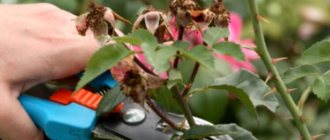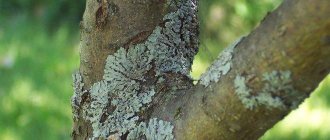And these days, the ideal beauty of the rose evokes incredible delight. But in order for it to appear in all its colors and aromas in the spring, it cannot be done without proper care, an important part of which is autumn pruning before covering it for the winter. And this is a separate story, and there are no trifles here.
We will talk about why to prune, when it is best to do it, what are the features of pruning each variety of “queen of flowers”, what general rules should be followed, as well as how best to prepare a rose for winter, will be discussed in our article.
Pros and cons of autumn pruning roses
Benefits of autumn pruning:
- It is more convenient to cover a trimmed plant for the winter.
- The plant accumulates nutrients that will help it develop in the spring.
- The growth of new shoots is increasing.
- The root system develops better.
- The number of flower stalks increases.
- Plants are better protected from infections and fungi.
The downside of autumn pruning is stimulating the growth of dormant buds if the average temperature at night rises to above zero. Buds that develop will not survive subsequent frosts. This threatens illness and death of the escape.
Pruning roses according to the lunar calendar
Based on the lunar calendar, gardeners have learned to regulate the growth of rose bushes.
Topping
For example, by pinching young shoots at the quadruple leaf stage, you can activate the growth of new, well-developed shoots.
And the growth of young strong shoots has a beneficial effect on the development of the plant’s root system. This pinching is very useful for adult plants, so that they become stronger by winter and begin to develop better.
By pinching the branches, you can shift the flowering time in the right direction. In September, pinching stops; the plants need to be prepared for wintering.
A haircut
Plants should be trimmed when the air temperature no longer rises above +10 degrees. This is important for flowers. Plants may begin to grow, confusing autumn with spring. Therefore, keep an eye on the weather forecast. View the lunar calendar and grow lush, beautiful roses.
Dear friends, the question: whether it is necessary to prune roses in the fall is no longer so pressing. Autumn pruning is a mandatory procedure, which will allow the queen of flowers to overwinter well and bloom her royal buds again in the spring.
How to prune roses?
All roses, regardless of when they were planted, need to be cleaned in the fall. The pruning tool must be sharp and disinfected.
We will need:
- Garden file, lopper for removing thick branches.
- Secateurs for cutting and trimming thin branches.
- Thick gloves to protect hands.
- Garden var.
- Rake.
Trimming rules:
- Dry, preferably sunny, weather.
- Use a sharp tool. With a blunt instrument you will damage, “chew” the bark and it will peel off.
- For proper development, maintain the proportion - the length of the roots is equal to the length of the above-ground part.
- Thick branches with a diameter of more than 1 cm should be trimmed with a lopper or saw.
- Remove all damaged or diseased wood from the central branches to a healthy location. It differs in color from the affected part of the plant, the bark is green and the cut is white.
- Make a cut above the outer, developed, but unopened bud.
- The cut is made obliquely, approximately 45°, so that moisture drains 1 cm above the outer bud with the cut inward.
- Cover all cuts with garden varnish, and cover the plant itself with an antifungal agent, possibly a solution of copper sulfate.
When the weather becomes consistently cold and frosty, the plants need to be earthed up. To do this, use ordinary soil, but not from under the bush, so as not to injure the roots. The bush is covered with earth, then covered with coniferous branches - spruce branches.
Preparing roses for winter
From the beginning of August, the application of nitrogen fertilizers to the soil is stopped, but just at this time it is necessary to carry out the first strengthening winter root feeding of roses, which consists of 25 g of superphosphate, 2.5 g of boric acid (or 3.5 g of borax) and 10 g of sulfate potassium dissolved in 10 liters of water. This amount of solution should be enough for 4 m² of area. The second strengthening fertilizer is applied to the soil a month later - at the beginning of September: 16 g of potassium sulfate, or potassium monophosphate, and 15 g of superphosphate are dissolved in 10 liters of water.
But it is better to carry out foliar treatments of roses instead of root treatments - spray the bushes on the leaves with the same solutions, but in a concentration three times less than with root feeding.
From the beginning of autumn, they also stop loosening the soil under the bushes, so as not to provoke the growth of shoots from dormant buds, and from mid-September, they pluck out all the buds that are smaller than a pea, and those that are larger in size are allowed to ripen and form fruits.
- Eschscholzia: growing from seeds, planting and care
In the photo: Trimmed rose bushes before wintering
Which roses should not be pruned for the winter?
Roses that bloom once in the summer are not subject to autumn pruning. Why?
Because they don’t need shelter, because... They can easily withstand fairly severe frosts, which means there is no need to lay them down and bend them to the ground.
Thus, there is no need to prune the following types of roses for the winter:
- park (bush);
- ground cover;
hybrid (for example, wrinkled).
When to prune roses for winter
It is necessary to carry out autumn pruning of roses before sheltering for the winter during the first night frosts, but preferably before the onset of stable frosts. If this is done ahead of time, then pruning will certainly stimulate completely unnecessary and destructive shoot growth at this time.
Need to know! Stable frosts - both day and night the temperature is consistently below zero.
Frosts are a minus only at night.
As a rule, pruning is carried out immediately before sheltering for the winter, in other words, these two procedures are combined.
Thus, the timing of pruning depends on where you live and the climate.
The approximate timing of pruning roses for the winter in the middle zone (Moscow region) is the second half of October - early November, as well as in the Leningrad region, as well as in the Volga region. In cold northern regions (in the Urals and Siberia) - at the end of September-October. In the south of Russia - in late autumn, that is, not earlier than November.
By region
Pruning work is carried out when the night temperature drops below 0, and during the day it will not be warmer than +5. At this time, life processes slow down, the plant is at rest.
Dates when to prune roses in the fall by region and country:
In the Moscow region and the central zone, the right time to trim rose bushes is mid-October. Pruning is carried out until the end of the month in warm weather.
In the Leningrad region, roses are prepared for winter until October 15. The installation of the shelter is carried out until the second ten days of November.
The weather in Siberia and the Urals does not allow delaying autumn work in the garden. Perennials are pruned at the end of September. In October, the bushes should already be securely covered with sawdust and non-woven material.
In the southern regions of our country, as well as in Belarus and Ukraine, the climate is mild and autumn is warm. Roses are not trimmed before November. It is not necessary to cover the shrub; there are no severe frosts that can destroy the plant. It is enough to add sawdust or shavings to the base of the bushes.
According to the lunar calendar
Favorable days for cutting, fertilizing and other work with plants are as follows:
- October – from 10 to 16, from 20 to 24, from 25 to 30;
- November – from 3 to 6, from 8 to 12, from 17 to 22.
Features of pruning for each variety of roses
Pruning forsythia - how and when to do it
Each variety requires a special approach to pruning. Knowing these features helps to achieve a large number of buds next season.
Pruning standard roses in autumn
All standard species can suffer from excessive pruning in winter. They are in danger of freezing out. During the autumn months, all flowers are removed from the trees. Next, the haircut is carried out depending on which variety is grafted onto the standard.
Roses that were planted in the fall can be pruned for the first time next year in the spring.
Pruning climbing roses for the winter
When cutting climbing roses before wintering, focus on their type:
- On tall bushes, reaching 2 meters, with large flowers, the stems are cut by a third. In this case, plants can do without the procedure. You can bend the branches to the ground and then cover them.
- Miniature specimens with small flowers are not shortened. It is enough to pinch the growth point.
Autumn pruning of hybrid tea roses
After a warm summer and good shoot growth, hybrid tea varieties are shortened by ½ or slightly less. This allows you to prepare the plants for winter and prevent them from freezing. In addition, it becomes easier to build a shelter for cut bushes.
Pruning floribunda roses for the winter
The degree of pruning of floribunda roses determines the height and spreading of the plants next year:
- When the stems are cut close to the soil surface, the bushes become stunted but lush, with many buds blooming on them.
- If a light pruning is carried out, then with the onset of spring and summer the plants stand tall, but not spreading. Flowers mainly bloom at the crown.
Important! Floribunda roses are usually cut in half. This simplifies the process of constructing winter shelters.
Autumn pruning of polyanthus roses
Polyanthus roses are cut not in the fall, but in the spring. During this period, all parts of plants damaged by frost are removed. The branches are shortened by 1/3 of the length so that the center of the bush remains free.
In preparation for winter, it is enough to remove flowers and dead stems
Pruning roses in the fall for beginners for the winter
- Before starting work, you need to prepare the tool:
- garden pruner;
- garden saw for removing thick branches;
- var for covering cut wounds.
The pruning shears and saw must be sharp to ensure an even cut. To protect your hands from thorns, wear thick gloves.
If you are preparing to trim a large number of rose bushes, it is recommended to keep a solution of potassium permanganate or phytosporin ready. While working, dip the pruning shear blade into the solution and begin cutting the next bush.
Disinfecting the instrument will help prevent the spread of infection, if any.
Branch cuts must be made at an angle of 45 degrees, at a distance of half a centimeter from the bud. It is necessary to take into account which side of the branch the bud under the cut is located on, because it is from it that a new shoot will begin to grow in the spring. You should avoid pruning a branch above a bud that looks into the crown or downwards.
The cut with pruning shears should be made in one sharp movement, without leaving rags of bark on the branches.
The wound on the shoot must be treated with garden varnish, wax or special glue. Moisture will get onto the unprotected cut, microbes will get in, and the branch will begin to rot.
Sanitary pruning
The bush is removed from weak, diseased and damaged shoots. Remove excess branches, leaving no more than 7 shoots on the plant. Make sure that they are located evenly on the bush.
The florist needs to imagine what the bush will look like in the spring, covered with leaves, and leave those shoots that will not shade the crown.
Anti-aging pruning
Short haircut, in which all branches are removed at the root, over 3 years old. If the bush has not been cultivated for a long time and all its shoots are old, they are shortened as much as possible, leaving 2-3 buds on the stumps.
Pruning roses before planting
When planting rose seedlings in autumn, their shoots are pruned and shortened as much as possible, leaving no more than 3 buds on a branch. This will help the plant adapt more easily to a new location.
If the rose has an open root system, it is recommended to trim its roots by 3-5 cm to stimulate the growth of lateral roots.
Proper pruning of a young rose bush
In the first year of planting a rose bush, it is pruned quite short for the winter. In addition to removing weak branches, strong shoots are shortened to 14 cm. This type of pruning allows the young plant to successfully overwinter, covered with completely insulating material. Short pruning is not used on park and ground cover varieties of roses.
After flowering
To preserve the strength of the plant, all withered buds, along with a part of the stem of 8-10 cm, are removed from the bush. Unopened buds that formed on the rose too late are also cut off.
Basic principles of pruning
Only to those who are too lazy to read the recommendations for caring for roses do they seem capricious and sickly flowers. They need care, like other garden plants, but it is not as difficult as inexperienced gardeners think.
People who planted flowers and trees on their property probably already have tools to care for them. Manuals, magazines and advice from gardeners available on the Internet will help you properly prepare for the procedure of pruning plants in the autumn season. Television often shows programs dedicated to work on a personal plot.
Circumcision tools
You can buy a set of tools for pruning roses at a hardware store in the gardening department. They are often sold in greenhouses along with rose seedlings. There you will be able to consult with specialists and choose the most suitable tools.
Typically, to care for roses you need:
- garden knife;
- scissors;
- garden hacksaw;
- pruner;
- brush cutter
All tools must be sharp to ensure effortless pruning of rose bushes. The first two are intended for processing young and thin shoots, and the last ones cut off woody branches.
The pruner can handle branches up to 2.5 cm in diameter. The hedge trimmer is a large pruner. They can be used to shorten the thickest shoots due to their long handles. They need to be held with both hands.
The main convenience of a hedge trimmer when caring for roses is the ability to avoid pricking thorns. The blades of the tool will reach the most distant branches, and at the same time you will be able to keep your hands at some distance from the bush.
All garden tools usually have brightly colored handles with a non-slip coating. This makes them easier to find in green grass and use.
Preparation for the procedure
At the end of September, rose bushes are watered less frequently so that the growth of young shoots slows down. It is also important to stop active flowering. This is achieved by pinching out new buds. Before the winter cold, plants will need phosphorus-potassium fertilizers to accumulate more nutrients in the branches.
Before you start pruning bushes, all tools that you plan to use should be disinfected in a solution of potassium permanganate. In this way, it will be possible to avoid contamination of plants by microbes.
Having carefully examined the branches and assessed the size of the rhizome, you need to try to calculate the scale of the reduction in the volume of the bush. If the top and bottom are approximately equal, the rose will survive the winter more easily and will meet the warm season with full strength.
Rules for making cuts
Before starting work, you should read the instructions several times to understand how to properly prune roses for the winter. For example, the cut must be made at an angle so that moisture does not accumulate in it. Immediately after the procedure, the place where the shoot is cut should be treated with Rannet or a special varnish-balm.
The gardener must take into account that the new shoot will go in the direction where the bud above which the branch is cut is facing. True, this is of greater importance during spring pruning, when the bush is formed.
Trimming methods
Pruning is carried out in three ways. They depend on the length of the stem, the branching of the bush and the type:
- Short pruning is used for polyanthus and small-flowered species. During this pruning, 2-3 buds are left. It is rarely carried out, because there is a risk of the bush freezing.
- Medium pruning is most often used. The bushes are pruned to 35 cm from ground level, 5-7 buds remain on the branch. It is used for all types of roses, with the exception of climbing and ground cover roses.
- Long pruning is suitable when the buds are located on the top of the shoot. Roses are pruned a little or not at all. This pruning is suitable for large-flowered varieties.
Choose medium pruning if you have not decided on the type of rose.
Be sure to remove:
- Old shoots (over 3 years old),
- The shoots are white, young branches (they will not tolerate frost and will become a site for the development of the disease),
- Shoots growing inward.
- Dried buds, flowers, leaves.
Care after pruning
8-10 days after cutting the rose, the bushes are treated with antifungal drugs, as indicated above, and prepared for wintering (covered).
The cover for roses must be breathable; film is not suitable for this purpose. The plant is sensitive to high humidity and often suffers not from frost, but from the accumulation of moisture under cover during a thaw. To insulate roses use:
- large wood shavings, not small sawdust (they are pressed faster, preventing air from entering the plant);
- lutrasil, agrospan, spunboard - materials that are lightweight but retain heat;
- pieces of boards and bars for placing under the shoots of climbing roses so that they do not lie on the ground.
Cover the roses when it is a stable -5..-7 degrees outside. The insulation is removed gradually as soon as the snow melts from the rose garden.











